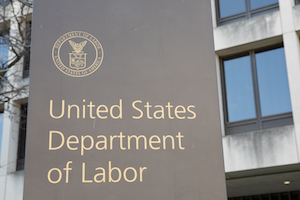The Department of Labor (DOL) announced Jan. 18 that its Employee Benefits Security Administration (EBSA) released a proposed regulation on automatic portability transactions under SECURE 2.0.
The DOL said automatic portability transactions aim to help workers keep track of their retirement savings accounts and improve retirement security by reducing cash-outs when they change jobs.
It cited the most recent annual Form 5500 data in noting there are an estimated 635,000 defined contribution plans in the United States, covering an estimated 86.6 million participants with account balances totaling $9.3 trillion in assets.
“With the widespread adoption of these accounts, there is a particular need for automatic portability solutions that help ensure participants remain connected to their retirement savings when they change jobs,” Assistant Secretary for EBSA Lisa Gomez said in a statement.
When workers leave jobs with a retirement benefit valued at $7,000 or less, their savings plan can automatically rollover their benefits to a safe harbor IRA if the plan document allows it and the employee does not take action after receiving required notices.
Auto-portability transactions involve automatically transferring workers’ retirement savings from their safe harbor IRA to their active account in a retirement plan sponsored by their new employer.
The department’s proposed rule would implement Section 120 of the SECURE 2.0 Act, which allows an automatic portability provider to receive a fee in connection with executing an automatic portability transaction for certain distributions into Safe Harbor IRAs, through an added exemption to Internal Revenue Code Section 4975.
Rolling over a retirement account to a new employer when changing jobs has long been a source of frustration for participants. The automatic and seemless transfer would also reduce the rate of "cash outs" and other forms of retirement plan leakage, something that frims like Retirement Clearinghouse have noted for some time.
"We appreciate the guidance provided by the DOL," American Retirement Association CEO Brian Graff said. "Anything that reduces the rate of retirement plan leakage results in better outcomes for participants."
The proposed regulation tracks the requirements under the statutory exemption that must be satisfied for the automatic portability transaction to be covered. These include:
- Scope of the exemption.
- Disclosures about automatic portability transactions, fees, compensation, and services, including an acknowledgment of the automatic portability provider’s fiduciary status, website requirements for the automatic portability provider, and a requirement that disclosures be written in a culturally and linguistically appropriate manner.
- Investments permitted in connection with automatic portability transactions.
- Restriction on receipt or payment of third-party compensation by an automatic portability provider in connection with an automatic portability transaction.
- Prohibition on exculpatory provisions disclaiming or limiting liability if an automatic portability transaction results in an improper transfer.
- Required actions to ensure that participant and beneficiary data is current, accurate and secure.
- Limitations on the use of data related to automatic portability transactions for any purpose other than to execute such transactions or locate missing participants.
- Record retention requirements.
- Annual audit and corrections procedures if an auditor determines the automatic portability provider did not comply with the requirements of the statutory exemption and the proposed regulation.
The Notice of Proposed Rulemaking is posted on the department’s website and will be published in the Federal Register with a 60-day public comment period and instructions on how to submit comments.
- Log in to post comments
